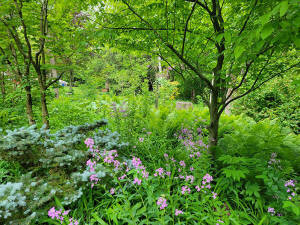|
A layered landscape provides space
for wildlife all year
[March 19, 2025]
There are many ways to support pollinators and
other wildlife in home landscapes, such as providing floral
resources throughout the season, planting host plants, and planting
native plants. In addition, consider creating a space for them to
live out their life cycles by creating vertical layers in the
landscape.
Natural Systems as Models
Take a look at natural systems such as forests and prairies, and
layers of vegetation will be evident. Forests consist of grasses,
flowers, shrubs, understory, and canopy layers. Prairies also have
distinct layers throughout the season, from low-growing early-season
plants to the tallest late-blooming flowering plants and native
grasses.
By mimicking these natural layers, space is provided for pollinators
to complete their entire life cycle from larvae to adults. Layers
also offer sheltered spaces for other wildlife, from frogs to birds
to mammals.
Keystone Tree Species
One important thing to consider is adding keystone tree species to
the layers. Keystone species are a relatively small number of plants
that support many animal species. Oaks, willows, cherries, pines,
and poplars support many moths, butterflies, and other beneficial
insects.
Adding keystone trees is an essential first step to support
wildlife, but creating layers of shrubs, flowers, and grasses
underneath the trees is critical to support pollinator and
beneficial insect populations at all stages of their life cycle.
Creating Space for Wildlife to Thrive
According to pollinator conservationist Heather Holm, “Soft Landings
are diverse native plantings under keystone trees (or any other
regionally appropriate native tree). These plantings provide
critical shelter and habitat for one or more life cycle stages of
moths, butterflies, and beneficial insects. In addition to plants,
soft landings include leaf litter, duff, and plant debris.”
Turf grass underneath trees can struggle to thrive in shaded areas
and is limited in its ability to support diverse animal species.
Adding plugs of various native plants underneath established trees
is a way to create soft landings without damaging the tree roots.
Adding Native Plants
Native ferns, sedges, and flowering plants are good additions
underneath a tree to create layers.
Ferns can provide shelter and a safe space for overwintering
animals. Some native ferns that can be good additions are maidenhair
fern (Adiatum pedaltum), lady fern (Athyrium filix-femina), and
Christmas fern (Polystichum acrositchoides).
[to top of second column] |

A layered landscape has canopy and understory trees, shrubs, flowering plants,
and shrubs. Photo by Nicole Flowers-Kimmerle, Illinois Extension.

Sedges provide a grass-like texture to shaded areas. Some native
sedges that provide soft landings are Pennsylvania sedge (Carex
pensylvanica) and rosy sedge (Carex rosea). Bottlebrush grass (Elymus
hystrix) is another addition to a shaded area that provides
structure.
A variety of flowering plants can be added to the shaded ground
layer. Many flower in the spring before the tree canopy is
filled with leaves, but others flower throughout the season.
Consider adding some of these native flowers: wild columbine
(Aquilegia canadensis), wild geranium (Geranium maculatum),
Virginia bluebells (Mertensia virginica), zigzag goldenrod (Solidago
flexicaulis), and common blue violet (Viola sororia) to name a
few.
Adding a variety of native plants under established trees allows
pollinators, beneficial insects, and other wildlife space to
thrive in a home landscape.
For questions on natural landscaping, connect with a local
University of Illinois Extension office from the
statewide map.
[Text received from Anita Wilkinson
Communications Program Coordinator]
 |